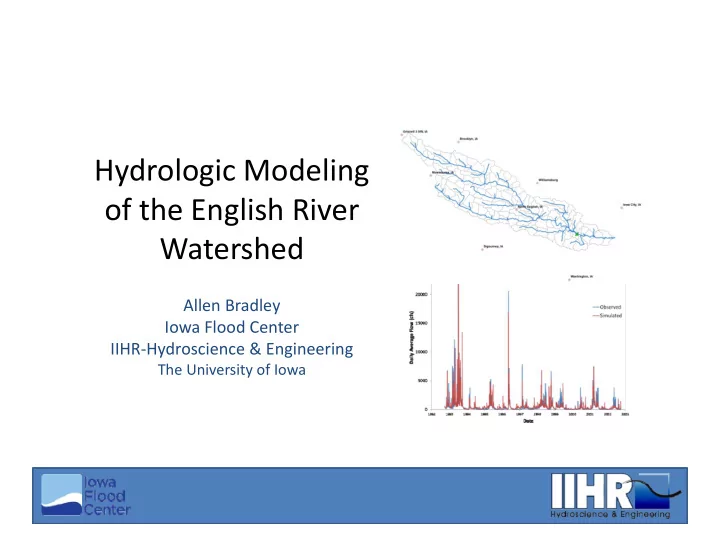

Hydrologic Modeling of the English River Watershed Allen Bradley Iowa Flood Center IIHR ‐ Hydroscience & Engineering The University of Iowa
We will assess the water cycle and flooding from model predictions Identification of high runoff and high flood areas The use of model predictions in interpreting water quality Examples of sampling hypothetical watershed scenarios
Hydrologic Modeling of the English River Watershed HSPF MODEL OF THE ENGLISH RIVER WATERSHED
The English River watershed is subdivided into 103 river reaches for flow prediction Application to the English River Watershed The average size of each river reach is about 6.1 mi 2 HSPF performs a long ‐ term continuous hourly simulation of watershed hydrology
Subdivision into land segments is based on land use and weather inputs Application to the English River Watershed Pervious Land Segments: 56 (7×8) Impervious Land Segments: 16 (2×8) HSPF performs a long ‐ term continuous hourly simulation of watershed hydrology 2013 Land Use Information (Iowa Soybean Association)
Hydrologic Modeling of the English River Watershed HIGH RUNOFF AND HIGH FLOOD AREAS
The fraction of precipitation that runs off varies across the English River watershed Areas with the highest runoff fractions are primarily a result of land use
Subbasins can be classified as low, medium, or high runoff areas Average annual runoff depth from the 64 ‐ year simulation Higher Runoff Medium Areas Runoff Lower Areas Runoff Areas
Subbasins can be classified as low, medium, or high runoff areas Higher runoff areas should be a priority for practices aimed at increasing infiltration
The mean annual flood tends to increase predictably with upstream drainage area Mean annual flood from the 64 ‐ year simulation Medium Floods Higher Floods Lower Floods
Subbasin outlets can be classified as low, medium, or high flood areas Higher flood areas should be a priority for evaluating the effects of proposed practices
Hydrologic Modeling of the English River Watershed IMPACTS OF HYPOTHETICAL ALTERNATIVE CONDITIONS
The hydrologic model can be used to explore alternative watershed conditions Alternative Land Use in the English River Watershed Existing Land Use Pre ‐ settlement Tall ‐ grass prairie scenario Scenario Land Use Assume existing row crops are replaced with tall ‐ grass prairie Deep rooted vegetations allow more water to infiltrate more quickly, and transpire more water
The hydrologic model can be used to explore improved agricultural hydrology Alternative Land Use in the English River Watershed Existing Land Use Agricultural best management practices scenario Scenario Land Use Assume existing croplands have full implementation of conservation best management practices Assume best runoff conditions for cropland areas
The hydrologic model can be used to explore flood management strategies Flood Storage in the English River Watershed Small (3 ‐ foot) 10.9 acre ‐ feet Medium (5 ‐ foot) 26.7 acre ‐ feet Large (7 ‐ foot) 48.2 acre ‐ feet Flood Storage Scenario Assume that 124 prototype ponds are installed in headwater reaches (1 pond per 2 square miles)
Changes in the land surface can have a significant impact on runoff generation Scenario effects on runoff Tall ‐ grass Prairie Scenario The average annual runoff depth is 8.3 inches (a 27% reduction) Prairie scenario runoff
Changes in the land surface can have a significant impact on runoff generation Scenario effects on runoff Tall ‐ grass Prairie Scenario The average annual runoff depth is 8.3 inches (a 27% reduction) Agricultural Management Scenario The average annual runoff depth is 10.8 inches (a 5% reduction) Prairie scenario runoff Agricultural management runoff
Changes in the land surface can have a significant impact on runoff generation Scenario effects on runoff Tall ‐ grass Prairie Scenario The average annual runoff depth is 8.3 inches (a 27% reduction) Agricultural Management Scenario The average annual runoff depth is 10.8 inches (a 5% reduction) Flood Pond Scenario The average annual runoff depth is 11.3 inches (no reduction)
The decrease in peak flow for a flood event is called the peak reduction effect Scenario effects on flooding
Flood peak reduction effect diminishes in the downstream direction Scenario effects on flooding
Flood storage can be design to be most effective for large flood events Scenario effects on flooding
Hydrologic Modeling of the English River Watershed WATER QUALITY SIMULATION (NITRATE)
Nitrate load for the 64 ‐ year simulation varies with land use across the watershed Current Conditions (Baseline)
The water quality snapshot characterized Nitrate at 20 locations in the watershed Iowa Soybean Association (2014)
Where load predictions are low (high), the snapshot saw low (high) concentrations Nitrate Snapshot for 17 July 2014 Some sites are anomalously ERW4 high compared ERW2 to model predictions
Where load predictions are low (high), the snapshot saw low (high) concentrations Nitrate Snapshot for 21 October 2014 Some sites are anomalously high compared ERW2 to model ERW4 predictions ERW5 Model predictions provide a valuable context for interpreting measurements
Hydrologic Modeling of the English River Watershed SUMMARY AND CONCLUSIONS
Modeling can help us assess the water cycle and water quality of the watershed Model predictions were used to identify high runoff areas (a priority for practices) and high flood areas (a focus for assessing the impacts of practices). Land use changes can have significant impacts on runoff and flooding. Flood storage can be targeted to reduce runoff effects for large floods. Model predictions of water quality can help us make sense of field measurements. 2/20/2015
Recommend
More recommend